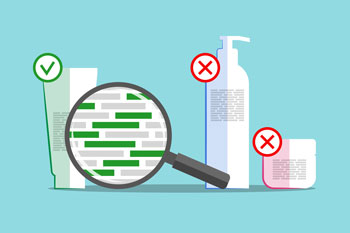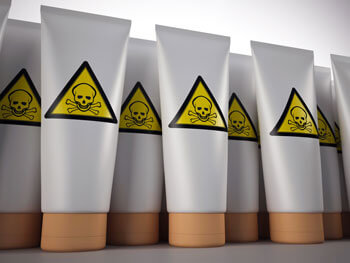The pressure on women to look “flawless” today is incredibly high. I came across a news article the other morning that stated, “women unknowingly put an average of 168 toxins on their bodies every day”. My jaw stuck! ONE HUNDRED SIXTY EIGHT ?
I immediately popped into my bathroom to scan my (embarrassingly large) cosmetic drawer, then started reading my labels. I discovered that many of my so-called “herbal” products actually contained harmful chemicals. But how is this possible?
It turns out that the regulations in Canada and the United States for cosmetic products are not so strict. Therefore, a company can use words like “natural” or “herbal” even though they actually contain harmful ingredients! Not great, right?
I also noticed that my shampoos, conditioners and gels were the worst of the lot. So what should a woman do?
Reading labels is our best line of defense. However, coping with a list of words you can't pronounce is about as understandable as ordering food from a drive-thru with your face mask on! (I still don't know why I was wearing my mask in the car, ladies!)
To give you a hand, I've put together a list of the 10 most common toxic ingredients found in hair products. Here is the list :

I mentioned these chemicals in a previous blog post and they are worth remembering. They are found in almost all cleaning products. Derived from coconut and found in most shampoos as a detergent that emulsifies to create lather or bubbles. They have been known to cause eye irritation, skin irritation, can cause dry skin, have a defatting power and have been linked to eczema.
I'm sure you've noticed the “paraben-free” label on many shampoo and conditioner bottles lately. It is estimated that 75-90% of cosmetics use parabens as preservatives. In fact, the single most frequently used ingredient in cosmetics is water. That being said, a 2004 study published in the Journal of Applied Toxicology indicated that parabens were a cause for concern. Researchers have found traces of parabens in 20 women with breast cancer. Parabens are considered to act like estrogens. This is because high levels of estrogen can cause breast cancer in some women. Other names for parabens are: methyl paraben, ethyl paraben, propyl paraben, butyl paraben.
This organic alcohol is used as a conditioning agent in relaxers, conditioners, liquid foundations, mascaras, deodorants, lipsticks, mouthwashes, perfumes and even suntan lotions. It is more permeable and less expensive than glycerin, but has been linked to eye, skin, and lung irritation.
Used in baby and adult shampoos as a solvent that makes harsh chemicals mild. It is a product suspected of being toxic. It is also an eye and respiratory irritant. It is suspected of causing damage to the central nervous system, liver and kidneys. Some workers have been accidentally exposed to 1,4 Dioxane, resulting in fatalities. Dioxide is classified by the International Agency for Research on Cancer (IARC) as possibly carcinogenic to humans, as it is known to be carcinogenic in animals.
Commonly used in dandruff shampoos and considered highly toxic. May seriously irritate eyes, cause dryness, or make hair or scalp oily. Some association with kidney, respiratory, heart, liver and blood toxicity is reported, and it is considered a carcinogen. The EU has banned selenium in cosmetics. Selenium sulfide should be mentioned on the label carefully to avoid contact with eyes or damaged skin.

Found in hair products, acrylamide is also used to make dyes, adhesives and nail polish. It is known to cause eye, skin and lung irritation. Very toxic, it is also known to be carcinogenic.
Formaldehyde is used in different cosmetic products such as hair products, nail hardeners, soap and nail polish. Skin reactions after exposure to this product are very common, as it can be both irritant and allergenic. Some surfactants, such as sodium lauryl sulfates, may contain formaldehyde as a preservative. This means that products may contain formaldehyde without it being indicated on the bottle. Formaldehyde is highly toxic to the human immune and respiratory systems and is linked to cancer. Sweden and Japan have banned formaldehyde in cosmetics and it is on the list of prohibited substances in Canada.
It is commonly found in hair dyes, bleaches, hair tonics and lipsticks. May cause allergic skin reactions. In 1992, the FDA issued an advisory that resorcinol has not been shown to be safe and effective. Resorcinol is toxic to the immune system and the EU requires it to be listed on the label with the warning: “Contains resorcinol; rinse the hair well after application; do not use to dye eyelashes or eyebrows; rinse eyes immediately if product comes into contact with them.
Paraffin is a synthetic wax made from petroleum and is also known as crystalline petroleum wax. Paraffins are suspected carcinogens and skin irritants. Paraffin can cause purpura, a condition characterized by skin hemorrhage.
Phthalates are mainly used as a plasticizer to give flexibility to rubber, plastic or resin. They are also used in cosmetic products such as hair products to moisturize and soften. They are related to toxins that affect reproductive and developmental abilities in males.
These are 10 commonly used chemicals that you can find in your hair products and other cosmetic products. I hope this article will encourage you to read the labels of your products as much as those of the food products you buy. Check out our organic hair products , and follow us on Instagram , where we post healthy hair and healthy lifestyle news daily!



